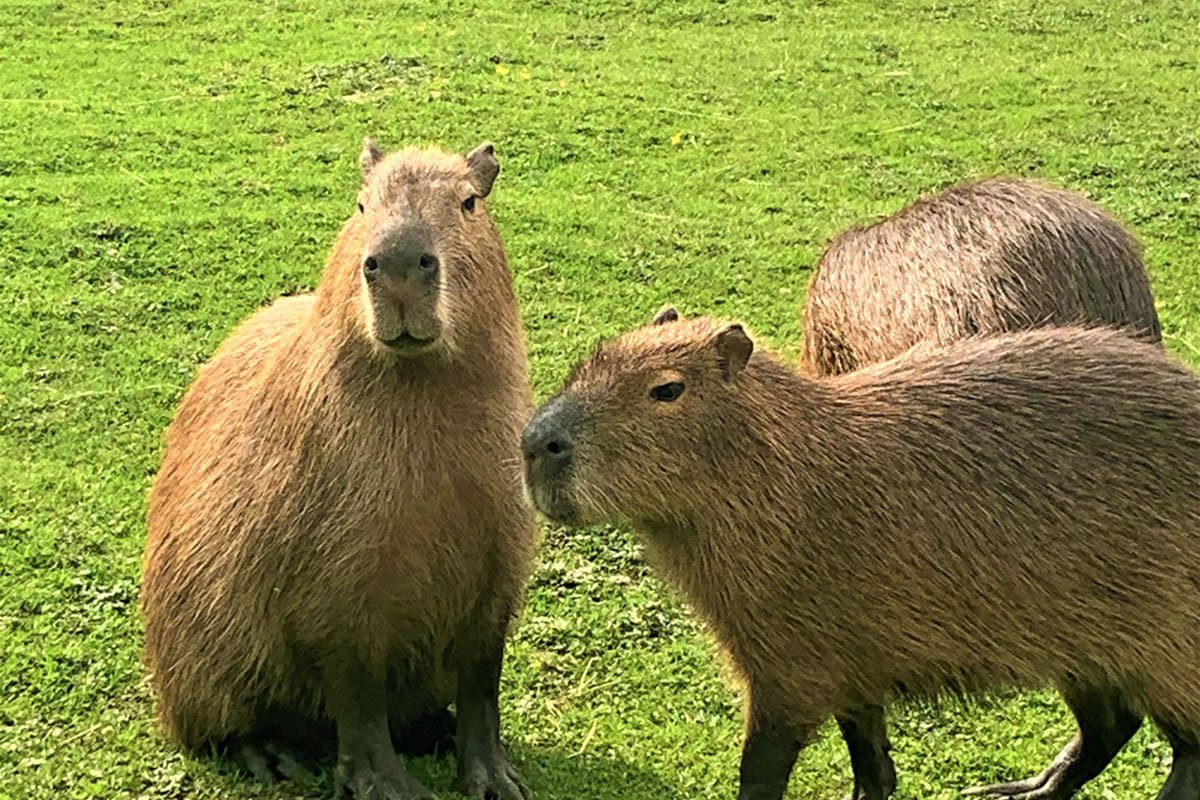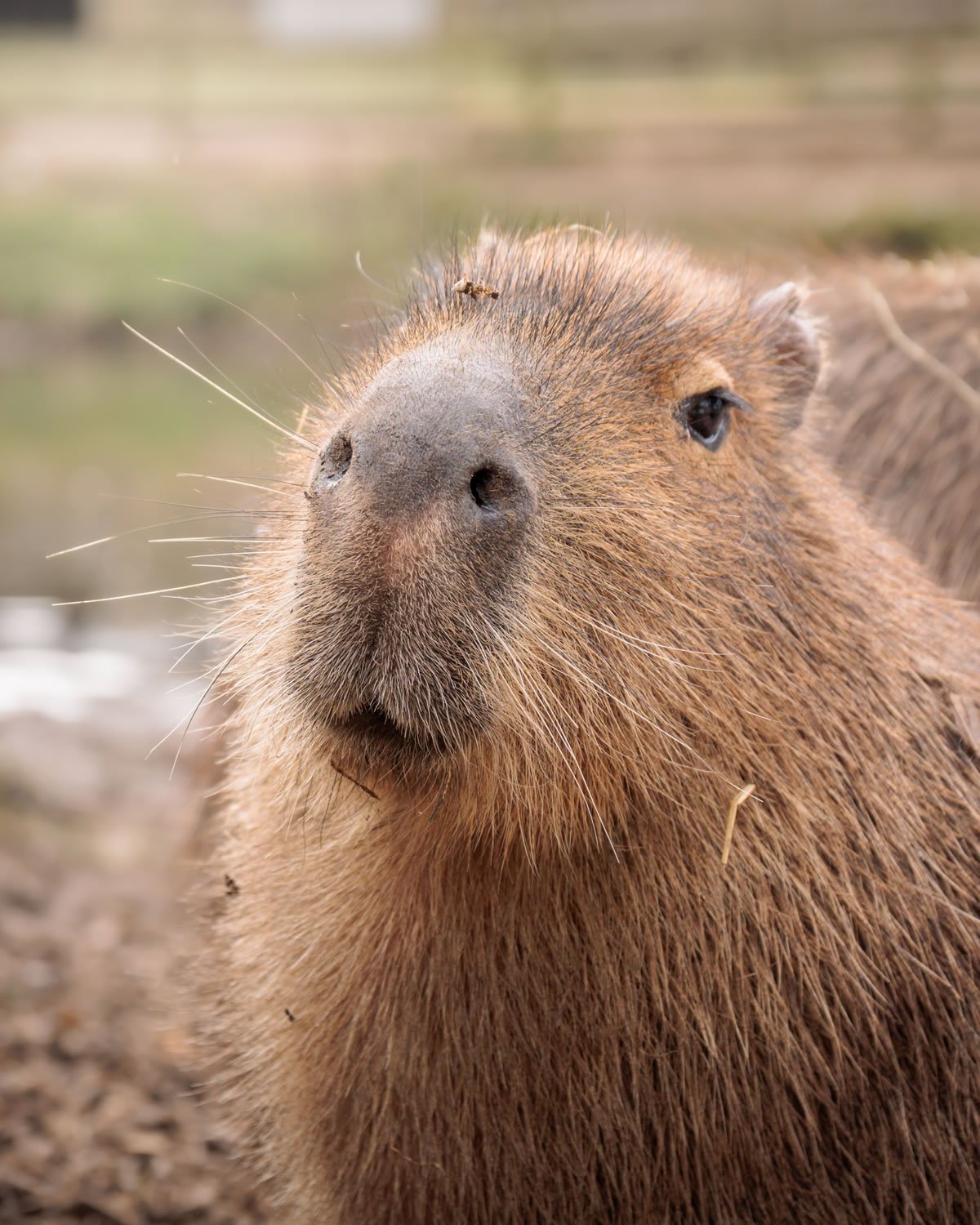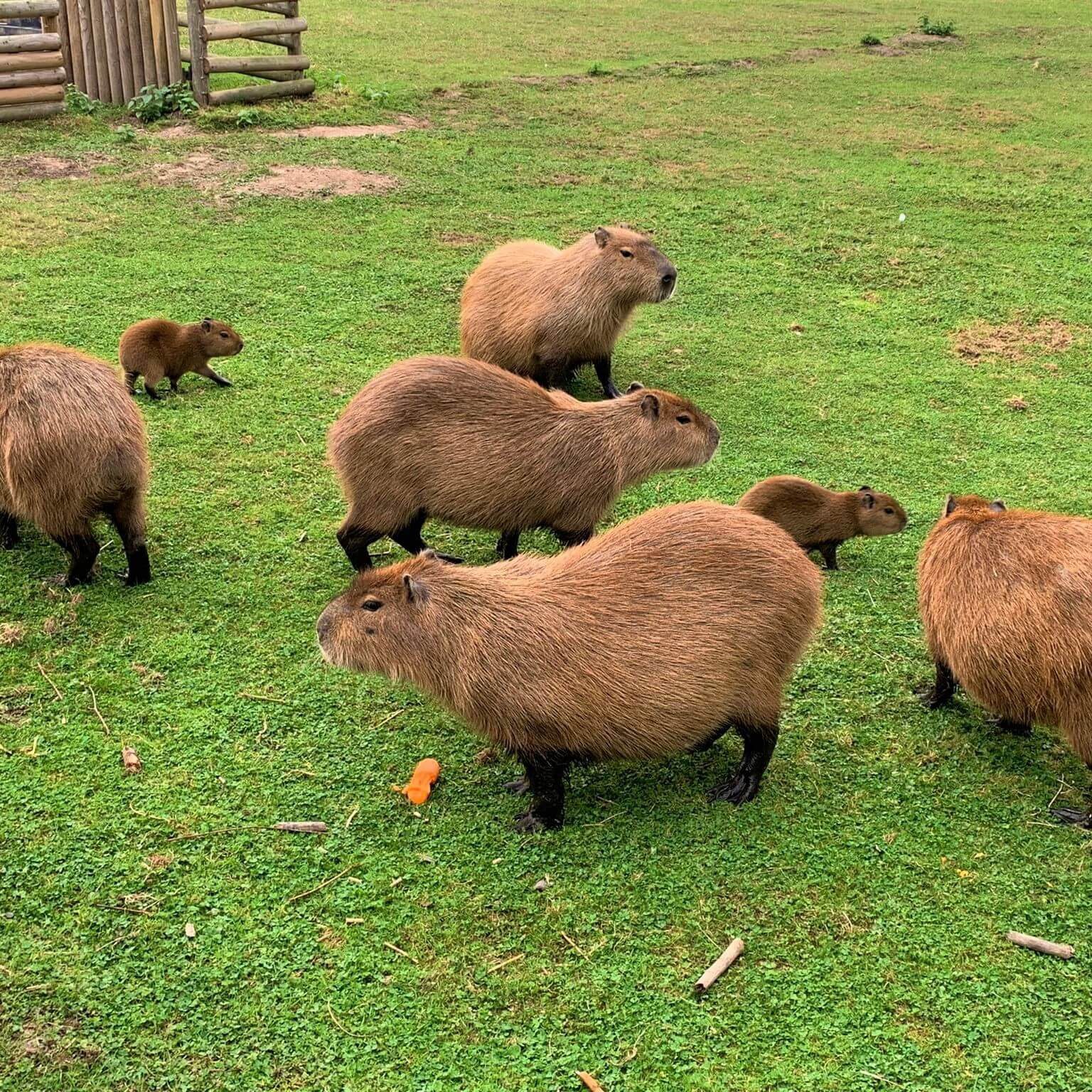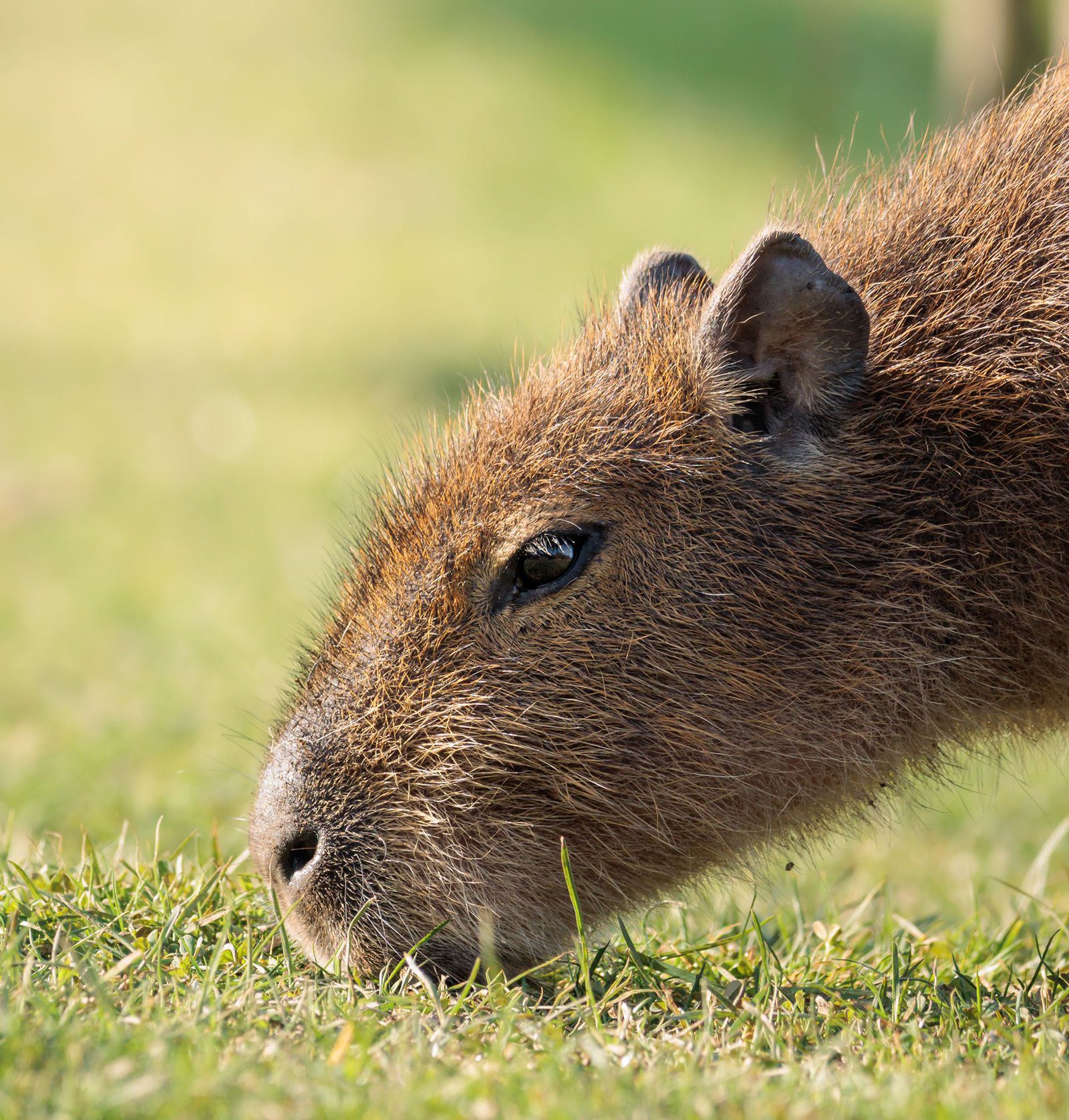Table of Contents
Have you ever heard of capybaras? These extraordinary creatures, known as the largest living rodents in the world, are a sight to behold. In this article, we'll take a journey to Jimmy's Farm, where the captivating world of capybaras comes to life. From their friendly and social behavior to their incredible adaptations, prepare to be amazed as we delve into the fascinating world of these unique animals. Get ready to discover the wonders that Jimmy's Farm has to offer, as we uncover the secrets of capybaras and immerse ourselves in their captivating habitat.

The Discovery of Capybara
Capybara, the largest rodent in the world, have long fascinated explorers and scientists alike. Originally discovered in South America, particularly in the wetlands and rainforests of countries such as Brazil and Venezuela, the capybara's natural habitat consists of freshwater areas, such as rivers, lakes, and marshlands. These semi-aquatic creatures have successfully adapted to thrive in these unique ecosystems, drawing much attention to their physical characteristics and remarkable adaptations.
Origins and Natural Habitat
Capybara, scientific name Hydrochoerus hydrochaeris, are native to South America. They can be found abundantly in the tropical and subtropical regions of Brazil, Venezuela, Colombia, and other neighboring countries. These herbivorous creatures have a preference for areas with dense vegetation, as they provide both food sources and adequate hiding spots. Natural habitats that support capybaras often include grassy plains, marshes, forest edges, and riverbanks. Their geographical range demonstrates their remarkable ability to adapt to various environments, from the Amazon Rainforest to the Pantanal wetlands.
Physical Characteristics
Capybara possess physical characteristics that enable them to thrive in their diverse habitats. They have a large, barrel-shaped body covered in coarse, brownish-gray fur, which varies in color and texture depending on their location. They possess webbed feet, ideal for swimming and navigating through water bodies. Additionally, these semi-aquatic mammals have eyes and nostrils situated high on their head, which allows them to observe their surroundings while mostly submerged. Capybaras have sharp, sturdy incisors that enable them to graze on grasses and other vegetation.
Unique Adaptations
One of the capybara's most remarkable adaptations is its ability to regulate its body temperature. Given their watery habitats, capybaras have developed a unique thermoregulation mechanism to maintain a constant body temperature. By taking frequent dips in water, they can stay cool during hot days, while their dense fur helps insulate them in colder climates. Furthermore, capybaras possess a specialized digestive system that efficiently breaks down fibrous plant material, allowing them to efficiently extract nutrients from their herbivorous diet.
Residence at Jimmy's Farm
At Jimmy's Farm, a picturesque farm located in the heart of Suffolk, United Kingdom, capybaras have found a welcoming and suitable home. The farm has created spacious and comfortable enclosures designed to mimic the capybara's natural habitat, complete with shallow water bodies, lush vegetation, and ample space for social interactions. This humane and carefully crafted environment ensures that the capybaras at Jimmy's Farm can thrive and display their natural behaviors, all while captivating visitors with their unique charm.
Capybara's Enclosure
The capybara enclosure at Jimmy's Farm is a stunning example of a well-designed habitat that caters to the needs of these fascinating creatures. It includes ample space for the capybaras to roam and explore, both on land and in the water. The enclosure features lush grasses, trees, and shrubs to replicate the capybara's natural diet and provide a sense of security. It also incorporates man-made ponds and streams, allowing the capybaras to indulge in their semi-aquatic nature. The enclosure's design prioritizes the capybaras' welfare, offering a safe and enriching environment.

Feeding and Diet
Capybaras are herbivores, primarily consuming grasses and aquatic plants. At Jimmy's Farm, their diet is meticulously catered to, ensuring a healthy and balanced intake of nutrients. The capybaras are provided with a variety of fresh vegetation, including grasses, leafy greens, and vegetables. By closely mimicking their natural diet, Jimmy's Farm guarantees that the capybaras receive the necessary vitamins and minerals to maintain optimal health. Visitors have the opportunity to observe these captivating creatures as they graze and munch on their meticulously prepared meals.
Social Dynamics
Capybaras are highly social animals, known for their complex group dynamics and close bonds within a community. At Jimmy's Farm, visitors have the privilege of witnessing these intricate social interactions up close. Capybaras live in large groups called “herds” or “bands,” consisting of multiple adults and their offspring. Within these herds, there is a well-established hierarchy, with one dominant male overseeing the group. Visitors may observe the capybaras engaging in grooming behaviors, huddling together for warmth or safety, and even communicating through a range of vocalizations.
Observing Capybara Behavior
While visiting Jimmy's Farm, take the opportunity to observe the captivating behavior of capybaras. These remarkable creatures exhibit a fascinating array of social interactions, vocalizations, and playful behavior, which offer insights into their intricate lives.
Social Interactions
Capybaras are highly social animals, and their interactions within their herds are both complex and intriguing. Observe as they establish dominance hierarchies, with the dominant male protecting his group. Capybaras bond through grooming, nibbling affectionately on each other's fur, strengthening their social ties. During periods of rest or when foraging together, you might witness the capybaras creating cozy piles as they huddle close to one another.
Vocalizations and Communication
Communication plays a vital role in the lives of capybaras, and they possess an impressive repertoire of vocalizations. Listen closely as they emit soft whistles, grunts, and purrs, often used to maintain contact within the herd or to alert others to potential dangers. Sudden loud barks may signal a perceived threat, prompting the group to take quick action. These vocalizations offer a fascinating insight into their level of social organization and coordination.
Playfulness and Recreation
Capybaras are renowned for their playful nature, and witnessing their recreational activities is an absolute delight. Watch as they engage in playful sparring matches, chasing one another through the enclosure, or even sliding across muddy banks with youthful exuberance. Their playful antics not only serve as a means of entertainment but also reinforce social bonds within the herd.

Capybara's Role in the Ecosystem
Beyond their captivating presence at Jimmy's Farm, capybaras play a crucial role in their natural ecosystems. Through their herbivorous diet, their ability to disperse seeds, and their profound influence on the surrounding habitats, capybaras contribute significantly to the balance of their environments.
Herbivorous Diet and Grazing Habits
Capybaras are strict herbivores, consuming large quantities of grasses, aquatic plants, and other vegetation. By grazing extensively, they help control the growth of vegetation, preventing overgrowth that could hinder the survival of other organisms. Their feeding habits play a key role in shaping the structure and composition of the plant community within their habitats.
Seed Dispersers
As capybaras munch on grasses and vegetation, they inadvertently become seed dispersers. Seeds easily attach to their fur and are transported to various locations as they move throughout their habitat. In this way, capybaras serve as important agents of seed dispersal, contributing to the growth and diversity of plant species within their ecosystems.
Ecological Importance
Capybaras act as ecosystem engineers, shaping their surroundings in numerous ways. By grazing on vegetation, they create open spaces that provide opportunities for other species to colonize and flourish. Capybaras also facilitate the availability of water sources by trampling vegetation, helping maintain clear paths to rivers and ponds. These activities have a profound impact on species diversity and the overall health of their habitats.
Capybara Breeding and Reproduction
The breeding and reproductive process of capybaras is an extraordinary phenomenon, characterized by intriguing mating rituals, a significant gestation period, and remarkable parental care.
Mating Rituals
During the breeding season, male capybaras engage in elaborate rituals to attract mates. They mark their territory and establish dominance by engaging in scent marking, vocalizations, and displays of physical prowess. Females select their partners based on these courtship displays, ultimately choosing the dominant male. This process reinforces social bonds within the herd and ensures the continuation of strong genetic lines.

Gestation and Birth
After a successful mating ritual, the female capybara undergoes a gestation period of approximately 150 days, one of the longest among rodents. During this time, she seeks out a secluded location away from the group to give birth. Typically, she delivers a litter of four to eight precocial young, who are born fully furred, with their eyes open and ready to explore the world. This unique reproductive process ensures the survival of the young, allowing them to adapt to their environment quickly.
Parental Care
Capybara mothers exhibit exceptional parental care towards their newborns. They provide warmth, protection, and nourishment through nursing. As the young begin to grow, they partake in communal parenting, with various adults within the herd assisting in their care. This shared responsibility strengthens the social bonds within the group, ensuring the survival and well-being of the capybara population.
Conservation Status and Threats
The conservation status of capybaras has garnered increased attention due to the threats they face in the wild. Understanding their vulnerabilities is essential to implementing effective conservation strategies.
Endangered or Threatened?
Currently, capybaras are not considered endangered or threatened globally. However, specific populations in certain regions are facing increasing pressures due to habitat loss and human conflicts. Monitoring their population dynamics is crucial to supporting their conservation in the long term.
Habitat Loss
As human populations expand and encroach upon natural habitats, capybaras face the loss and fragmentation of their homes. The clearing of land for agriculture, urbanization, and industrial activities directly impacts their ability to find suitable habitats. Compromised habitats disrupt their normal behavior patterns, their feeding habits, and the dynamics within their social groups.
Human Conflicts
Capybaras sometimes come into direct conflict with humans, primarily due to competition for resources and potential damage to crops. In some regions, they are hunted for their meat and hide, further depleting their populations. Finding ways to coexist and mitigate these conflicts is essential to ensuring the long-term survival of capybaras.

Cultural Significance of Capybara
Capybaras hold cultural significance in various communities around the world. From traditional beliefs and folklore to their role as pets, capybaras have weaved themselves into the fabric of human society in curious and endearing ways.
Traditional Beliefs and Folklore
In parts of the Amazon rainforest, indigenous communities regard capybaras as sacred animals. They believe that these creatures act as mediators between human and spiritual realms, often invoking their protective qualities in rituals and ceremonies. These beliefs and folklore reflect the deep cultural connections between humans and capybaras.
Capybara as Pets
Capybaras' friendly and social nature has led some individuals to keep them as pets in certain regions. Their popularity as companions stems from their affectionate personalities and their ability to form close bonds with humans. However, it is important to note that capybaras require specialized care, appropriate facilities, and should only be kept by those who can provide them with a suitable and enriching environment.
Cultural Depictions
Capybaras have become iconic figures in popular culture, appearing in various forms of media, including literature, art, and even as mascots for events and organizations. These depictions often highlight the capybara's gentle nature, their playfulness, and their ability to spark joy with their adorable appearance.
Interactions with Other Species
Capybaras share their habitats with a variety of other species, leading to diverse interactions and relationships that shape their environments.
Relationships with Birds
Capybaras often find themselves alongside different bird species, residing in the same wetland habitats. Birds such as herons, storks, and ibises take advantage of the capybara's presence, as their grazing activities create open areas ideal for foraging. Simultaneously, capybaras benefit from the birds alerting them to potential dangers and serving as additional “eyes” for the herd.
Predator-Prey Dynamics
As with any creature, capybaras also face the challenges of predator-prey dynamics. They must remain vigilant against potential threats, and their survival depends on their ability to escape from predators such as jaguars, anacondas, and caimans that inhabit their habitats. These interactions contribute to the overall balance of their ecosystems.
Mutualistic Partnerships
Within their habitat, capybaras form mutualistic partnerships with certain species, benefiting both parties involved. In particular, birds known as oxpeckers form a mutually beneficial relationship with capybaras. These birds perch on capybara's backs and feed on parasites and ticks, removing potential health hazards for their host. This symbiotic partnership showcases the interconnectedness and dependency between species in nature.
Scientific Studies and Research
Scientific studies and research regarding capybaras focus on various aspects of their behavior, ecology, and conservation. By further expanding our understanding of these charismatic creatures, experts can better implement conservation efforts and promote their overall well-being.
Capybara Ecology and Behavior
Scientists delve into the ecological role of capybaras within their habitats, examining their feeding habits, grazing impacts, and interactions with other species. Through comprehensive studies, researchers gain insights into the behavioral patterns and social dynamics within capybara herds, shedding light on their complex social structures.
Understanding Capybara Populations
To effectively manage capybara populations and protect them, scientists conduct population surveys and monitoring programs. These studies help identify population trends, assess any changes that may occur, and formulate appropriate conservation strategies. By understanding population dynamics, researchers can ensure the preservation of capybaras in their natural habitats for future generations to enjoy.
Conservation Efforts
Given the growing threats faced by capybaras in the wild, conservation efforts are crucial for their long-term survival. Conservation organizations, researchers, and local communities work together to protect capybaras and the habitats they depend upon. These efforts include habitat restoration, opening dialogue with local communities, promoting sustainable practices, and implementing measures to minimize human-wildlife conflicts.
Comparing Capybara to Other Animals
While capybaras are unique in many ways, comparing them to other animals provides valuable insights into their distinctive qualities, behaviors, and adaptations.
Capybara vs. Beavers
Although capybaras and beavers share semi-aquatic habitats, they belong to different taxonomic families. Unlike beavers, which are known for their engineering prowess in building dams and lodges, capybaras do not exhibit similar behaviors. However, both animals play essential roles in their respective ecosystems, contributing to the ecological balance of their habitats.
Capybara vs. Nutria
Capybaras and nutrias, also known as coypus, share similarities, including their semi-aquatic nature and herbivorous diet. However, capybaras are significantly larger and have a more robust build. Nutrias boast a highly productive breeding rate, which can lead to ecological concerns when introduced to non-native habitats. Understanding the differences between these two species is essential for effective management and conservation strategies.
Capybara vs. Hippos
Capybaras and hippos share no direct taxonomic relationship, but both are renowned for their semi-aquatic lifestyles. Hippos, however, outweigh capybaras significantly in terms of size and exhibit more aggressive behavior. While capybaras are herbivorous and graze on vegetation, hippos are known to be omnivorous. Observing and understanding the behavior and biology of these species can highlight the remarkable adaptations of semi-aquatic animals.
As we explore the fascinating world of capybaras at Jimmy's Farm, we come to appreciate their rich natural history, their essential role in ecosystems, and their captivating behaviors. These incredible creatures remind us of the interconnectedness of all living beings, and the importance of their conservation and protection. Whether through scientific research, conservation efforts, or simply by appreciating their charm, we can all play a role in ensuring the sustainable future of capybaras for generations to come.

